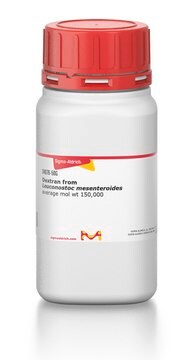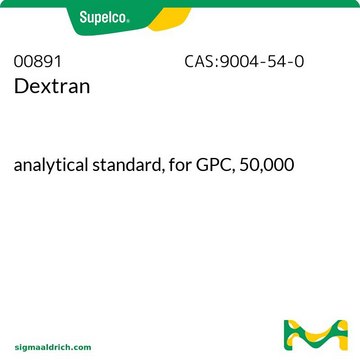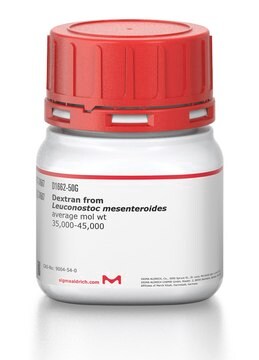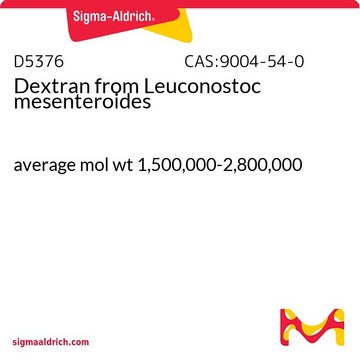31421
Dextran from Leuconostoc mesenteroides
analytical standard, for GPC, Mw 80,000
About This Item
Prodotti consigliati
Grado
analytical standard
for GPC
Livello qualitativo
PM
Mn ~55,000
Mp ~65,000
Mw ~80,000
Classi chimiche degli analiti
oligosaccharides
tecniche
gel permeation chromatography (GPC): suitable
Mw/Mn
~1.45
applicazioni
food and beverages
Formato
neat
InChI
1S/C18H32O16/c19-1-5(21)9(23)10(24)6(22)3-31-17-16(30)14(28)12(26)8(34-17)4-32-18-15(29)13(27)11(25)7(2-20)33-18/h1,5-18,20-30H,2-4H2
FZWBNHMXJMCXLU-UHFFFAOYSA-N
Cerchi prodotti simili? Visita Guida al confronto tra prodotti
Descrizione generale
Dextran from Leuconostoc mesenteroides (Mw: 80,000) may be used as an analytical standard to calibrate the column for gel permeation chromatography (GPC).
Applicazioni
Codice della classe di stoccaggio
11 - Combustible Solids
Classe di pericolosità dell'acqua (WGK)
WGK 2
Punto d’infiammabilità (°F)
Not applicable
Punto d’infiammabilità (°C)
Not applicable
Dispositivi di protezione individuale
Eyeshields, Gloves, type N95 (US)
Scegli una delle versioni più recenti:
Possiedi già questo prodotto?
I documenti relativi ai prodotti acquistati recentemente sono disponibili nell’Archivio dei documenti.
I clienti hanno visto anche
Il team dei nostri ricercatori vanta grande esperienza in tutte le aree della ricerca quali Life Science, scienza dei materiali, sintesi chimica, cromatografia, discipline analitiche, ecc..
Contatta l'Assistenza Tecnica.













